Adopting, Raising & Living With a Persian Cat
With their luxurious long coats and expressive flat faces, Persian cats have charmed cat lovers for centuries. Originating in Persia (modern-day Iran), these regal cats were bred for companionship and admired for their calm, gentle temperament. Their distinctive looks, affectionate nature, and indoor adaptability make them especially popular among Indian pet parents. Persian cats thrive in quiet homes, offering endless cuddles and aesthetic appeal—making them the top choice for those seeking a loyal, low-energy feline friend.
What are the pros and cons of adopting a Persian cat?
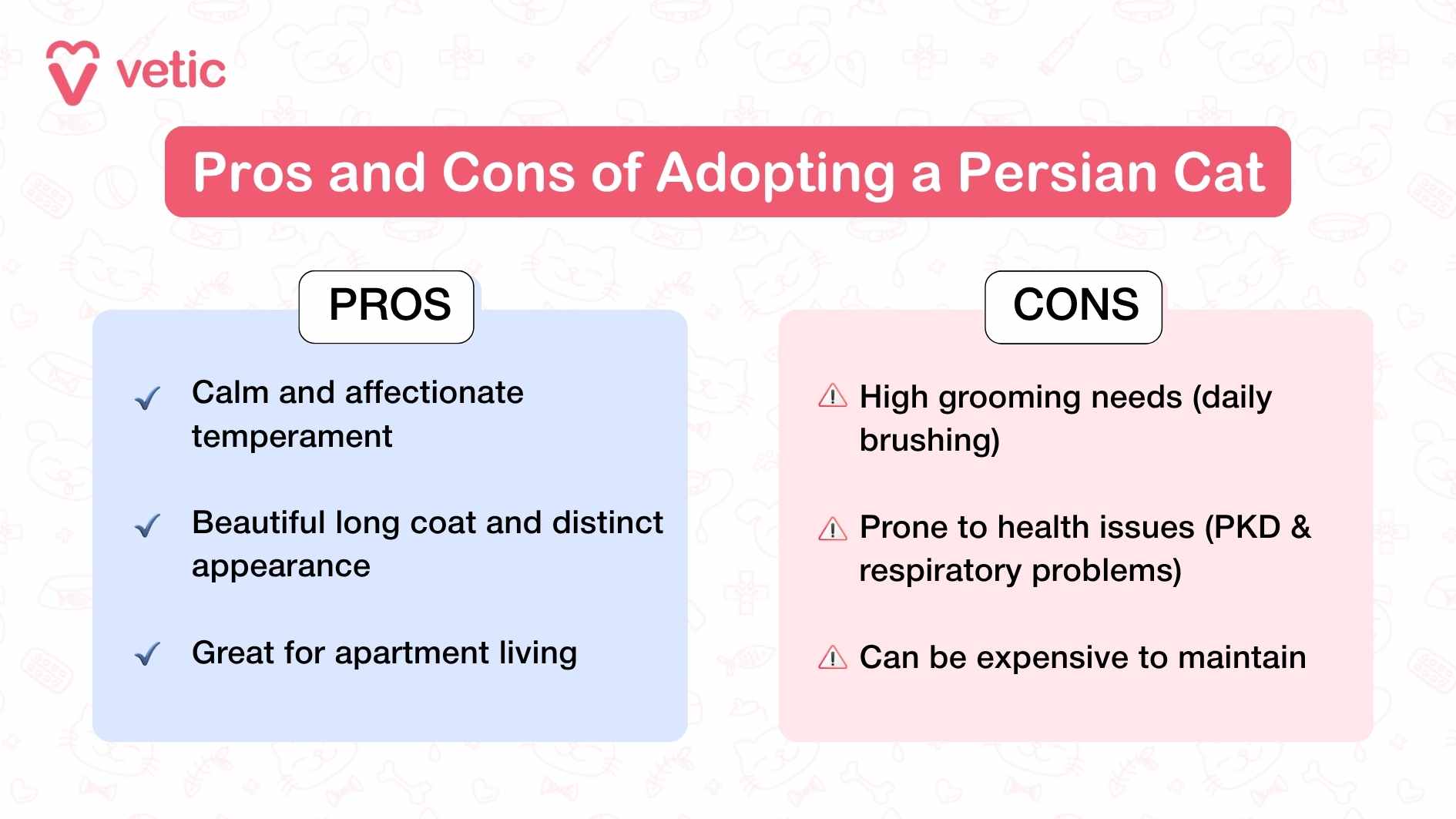
Persian cats are affectionate, calm, and beautiful, known for their luxurious coats and gentle temperament. They thrive in quiet indoor environments. However, their grooming needs are intensive—daily brushing and regular eye and ear cleaning are essential. Dr Abhishek Choudhary, BVSc & AH, says, “They are prone to genetic conditions like Polycystic Kidney Disease and respiratory issues due to their flat faces.” Persian cats are among the most high-maintenance breeds and need committed care. Adoption is rewarding but requires time and resources.
Should I adopt a Persian Cat?
You should adopt a Persian cat if you’re looking for a calm, cuddly, and beautiful companion and are willing to invest time in daily grooming and regular vet care. They are best suited for indoor lifestyles and quiet households. If you travel frequently or have a very active home, a Persian may not be ideal. Consider your lifestyle and ability to meet their grooming and healthcare needs before adopting. Adoption from a verified breeder or shelter that screens for PKD is recommended.
Are Persian cats suitable for first-time pet parents?
Persian cats can be suitable for first-time pet parents who are committed to daily grooming and indoor care. Their calm and affectionate nature makes them great companions. However, they require more maintenance than other breeds due to their thick coat and flat face, which can lead to breathing and eye issues. Beginners should consult vets regularly and consider pet insurance due to breed-specific health concerns. If you’re a first-time parent with time to spare, they’re a loving choice.
Can I keep a Persian cat in a small apartment?
Yes, Persian cats adapt very well to small apartments. They are low-energy, indoor-loving pets that don’t require much space for exercise. Their quiet and laid-back nature makes them ideal for confined indoor settings. Just ensure there is enough room for a litter box, food and water bowls, and a cozy resting space. They also benefit from vertical climbing structures or cat trees for stimulation, even in smaller homes.
How much does it cost to maintain a Persian cat monthly in India?
On average, maintaining a Persian cat in India can cost Rs 2,000–6,000 per month. This includes high-quality treats, breed-specific food, dust-free, odorless and clumping litter, grooming essentials and toys, and preventive health care. Occasional professional grooming and vet visits add to this. If your cat has PKD or chronic conditions, medical costs may rise. Persian cats are among the costlier breeds to maintain due to their specific care needs.
What should I know before adopting a Persian kitten?
Before adopting a Persian kitten, know that they require lifelong grooming, a quiet indoor lifestyle, and regular vet check-ups. Ensure the breeder screens for Polycystic Kidney Disease (PKD) and has health certificates. Persian kittens need early socialization, frequent eye cleaning, and a warm, safe environment.
How do I litter train my Persian kitten?
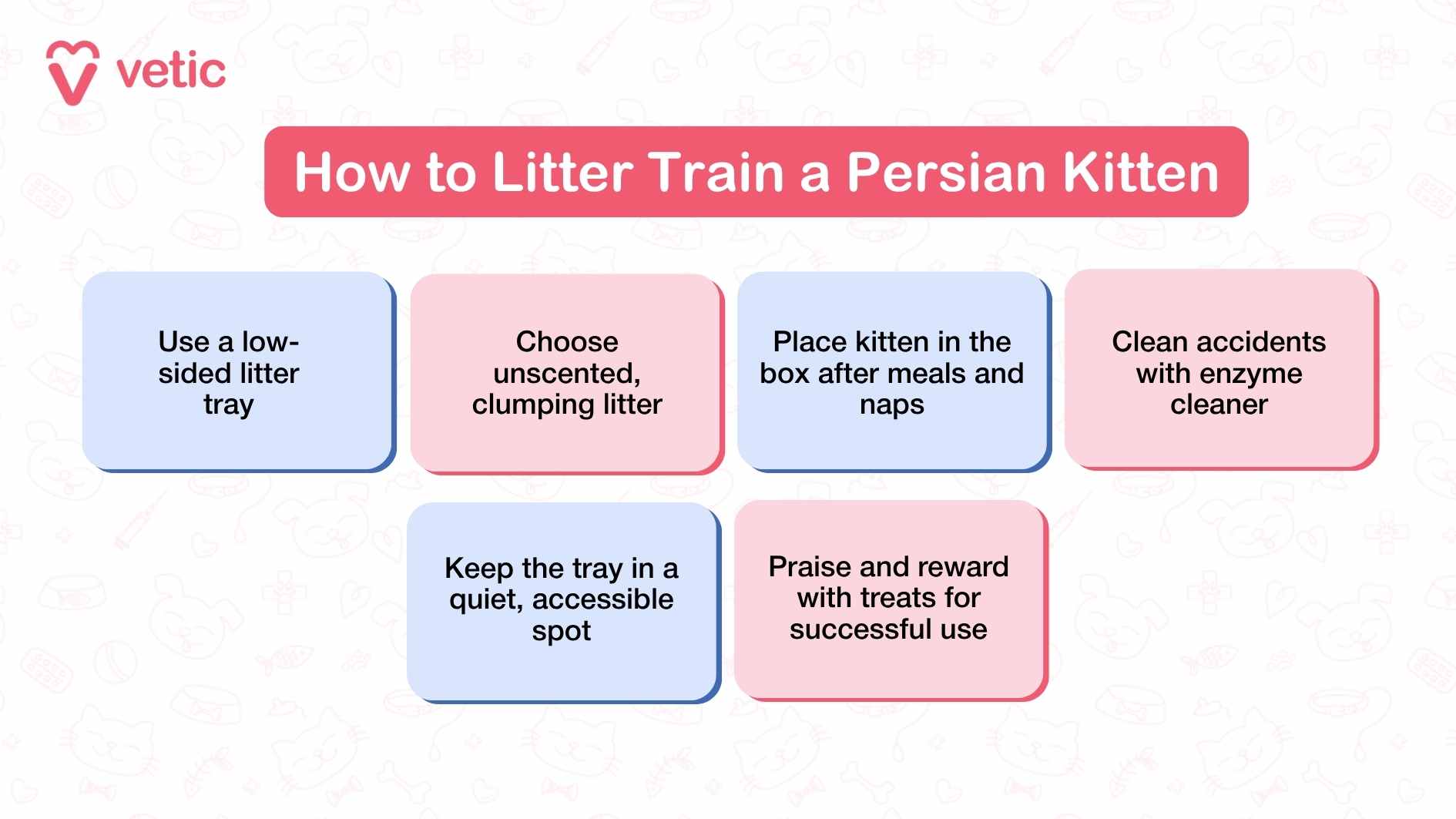
Litter training a Persian kitten is similar to litter training other cat breeds—start early, use a shallow litter tray, and place it in a quiet, accessible location. Show the kitten the tray after meals or naps. Keep it clean to encourage use. Avoid scented or clumping litters initially, as they may deter kittens. Consistency and positive reinforcement are key to success. Persian kittens usually adapt quickly with routine.
Are Persian cats indoor-only pets?
Yes, Persian cats are best kept indoors due to their flat faces, long coats, and vulnerability to infections and injuries. Their luxurious coat tangles easily and picks up debris outdoors. Their calm and curious nature also makes them less aware of dangers like traffic or stray animals. Persian cats are not well-equipped for outdoor survival. Indoor living ensures their coat and health are better maintained.
Do Persian cats get bored easily?
Yes, Persian cats can get bored without enough mental stimulation, even though they are low-energy. They benefit from interactive toys, puzzle feeders, window perches, and daily human interaction. Boredom can lead to destructive behavior or excessive sleeping. Rotate toys weekly, provide scratching posts, and engage in short play sessions. Despite their calm demeanor, they need enrichment to stay happy.
How much time should I spend with my Persian cat each day?
You should spend at least 30–45 minutes of active interaction with your Persian cat each day. This includes grooming, playtime, and gentle petting or lap time. Persian cats enjoy human companionship and may follow you around the house. Regular bonding reduces anxiety and improves behavior. Daily interaction also allows you to monitor their health and detect early signs of discomfort.
Can Persian cats be left alone at home?
Persian cats can be left alone for short periods—up to 6–8 hours—but extended isolation isn’t ideal. They are emotionally sensitive and may experience loneliness or separation anxiety. Make sure they have access to food, clean water, a clean litter box, and some mental stimulation (like toys or a cat tree). Hire a sitter or ask a friend to check in if you’re away longer than a day.
How often should I clean my Persian cat’s eyes and ears?
You should clean your Persian cat’s eyes daily and ears weekly. Their flat faces make them prone to tear staining, and their small ear canals can trap dirt. Use a damp cotton pad or vet-approved wipes for the eyes, wiping from inner to outer corner. For ears, use a soft cloth or ear cleaner recommended by your vet—never insert anything deep inside. Regular hygiene prevents infections and maintains comfort.
Nutrition & Feeding Questions
Can Persian cats eat homemade food?
Yes, Persian cats can eat homemade food, but it must be nutritionally balanced and vet-approved. A healthy homemade diet should include the right ratio of protein, fat, taurine, and essential vitamins and minerals. Boiled chicken, pumpkin, rice, and cooked fish can be used as ingredients, but avoid seasoning or spices. Unbalanced homemade diets can lead to deficiencies, especially in growing kittens or senior cats. Always consult your vet or a pet nutritionist before switching to homemade meals.
What foods should I avoid feeding my Persian cat?
Avoid feeding Persian cats chocolate, onions, garlic, raw eggs, bones, dairy, and anything salty or sugary. Also, steer clear of human junk food and anything with artificial sweeteners like xylitol. Even small amounts of these substances can lead to toxicity, gastrointestinal issues, or organ damage. Persian cats, in particular, are prone to digestive sensitivities and urinary issues, so it’s best to stick to vet-recommended diets and avoid table scraps altogether.
How much should I feed a Persian kitten per day?
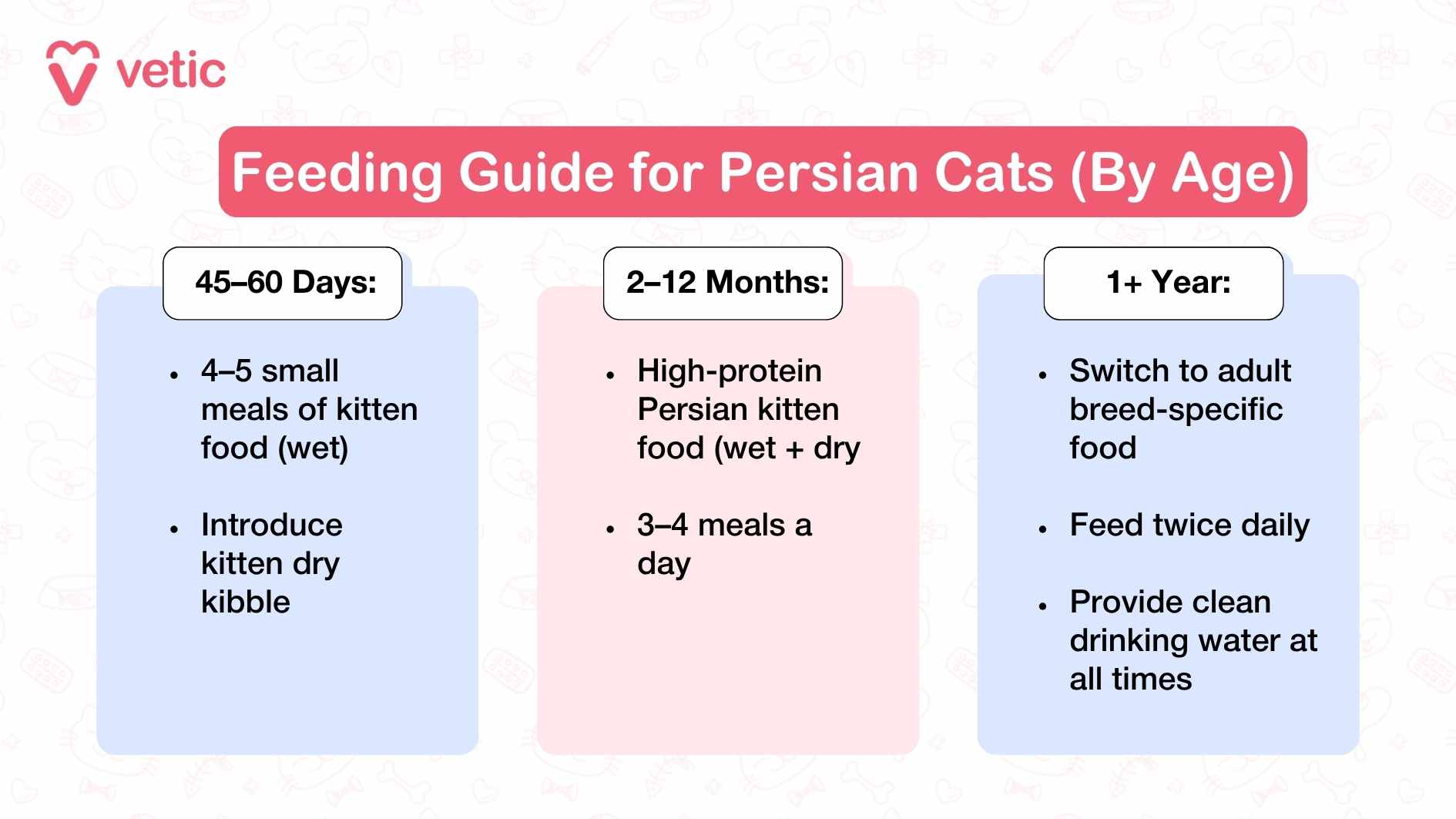 Feed a Persian kitten 4–5 small meals per day until 4 months of age, gradually reducing to 3 meals by 6 months. Quantity depends on age and food type—typically 60–90 grams/day of high-quality kitten food. Persian kittens need extra calories for growth, but overfeeding can lead to bloating or diarrhea. Follow feeding guidelines on the product and adjust based on weight and energy levels. We recommend weighing kittens weekly and consulting your vet to track growth.
Feed a Persian kitten 4–5 small meals per day until 4 months of age, gradually reducing to 3 meals by 6 months. Quantity depends on age and food type—typically 60–90 grams/day of high-quality kitten food. Persian kittens need extra calories for growth, but overfeeding can lead to bloating or diarrhea. Follow feeding guidelines on the product and adjust based on weight and energy levels. We recommend weighing kittens weekly and consulting your vet to track growth.
Is wet food better than dry food for Persian cats?
Wet food is often better for Persian cats due to their tendency to develop urinary and kidney issues. It contains more moisture, supporting hydration and reducing the risk of urinary crystals. However, dry food supports dental health and is easier to store. A mix of both – wet in the morning and dry in the evening – can offer the best of both worlds. Always choose breed-specific or vet-recommended formulations for Persians.
Should I give treats to my Persian cat? How many is too many?
Yes, you can give treats to Persian cats, but they should make up less than 10% of their daily calorie intake. Overfeeding treats can lead to obesity and nutrient imbalances, especially since Persians are not very active. Use healthy treats like freeze-dried meat or vet-recommended dental chews. Avoid sugary, colored, or high-carb treats.Use the treat allowance as a training or bonding opportunity—not a meal replacement.
Grooming & Hygiene Specifics
How do I remove tangles or mats from my Persian cat’s fur?
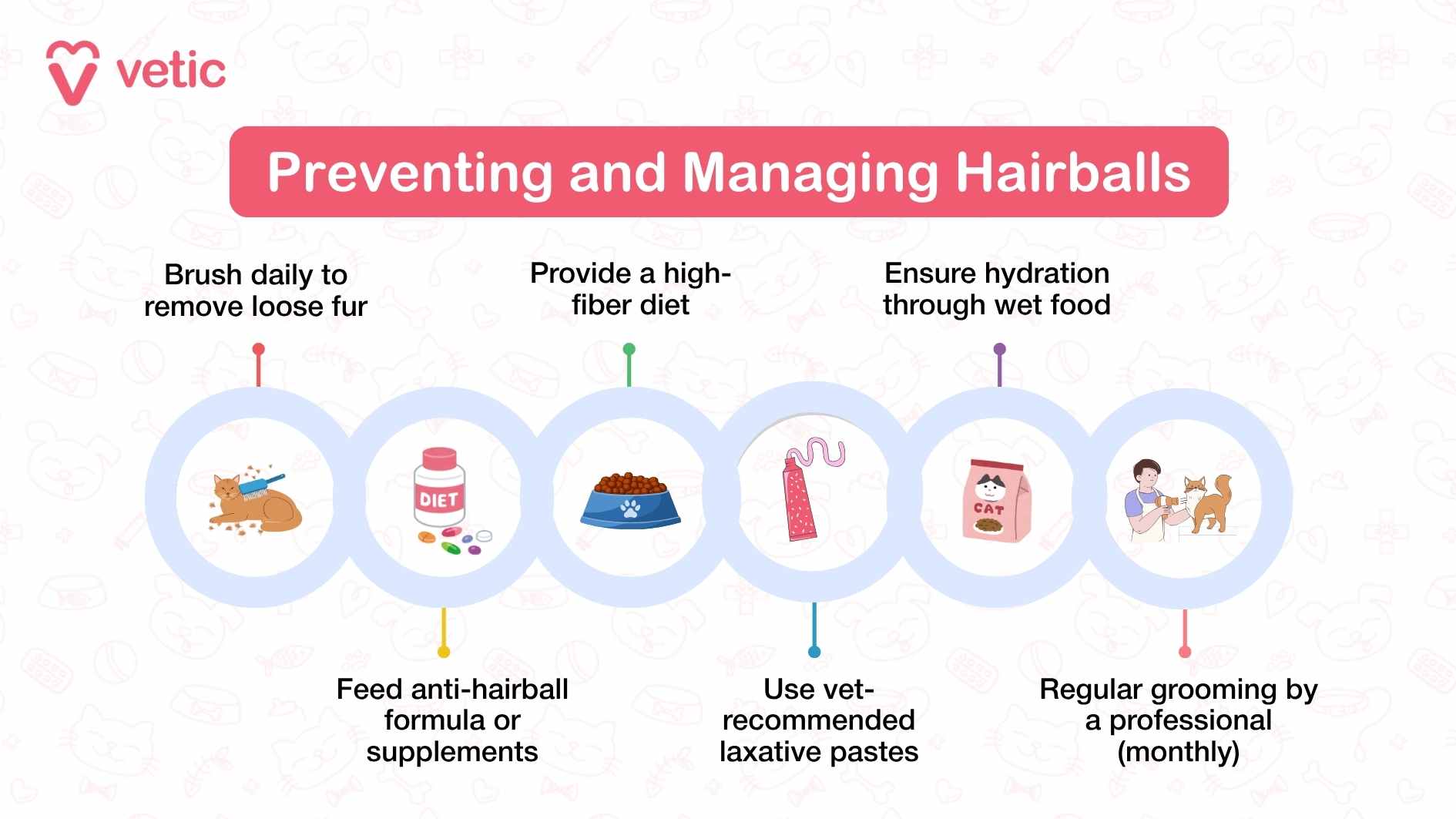
Use a wide-toothed comb or a detangling brush to gently separate tangles. Always hold the mat near the base to avoid pulling the skin. Start from the tips and slowly work towards the roots. For stubborn mats, use a detangling spray or blunt-edged mat splitter. Never cut mats with scissors—accidental skin cuts are common. Daily brushing can prevent matting in long-haired breeds like Persians, especially in friction-prone areas like armpits and behind the ears. When there are too many tangles and matts, take your cat to professional cat grooming services near you for a quick, pain-free and comfortable experience.
Can I shave my Persian cat in summer?
You can shave a Persian cat in summer, but only under veterinary or professional grooming supervision. While shaving may reduce matting and overheating, it can also expose the skin to sunburn and affect their natural coat insulation. The American Veterinary Medical Association (AVMA) advises against full shaving unless medically required. A better approach is a sanitary trim or lion cut to reduce fur bulk while preserving skin protection. Never use clippers at home without training—it can lead to cuts and stress.
What type of brush is best for Persian cats?
The best brush for Persian cats is a combination of a slicker brush and a wide-toothed metal comb. Slicker brushes remove loose fur and prevent shedding, while wide-toothed combs gently work through tangles and undercoat. For daily maintenance, a soft-bristle brush can also soothe the skin and help spread natural oils. Regular brushing prevents matting, improves circulation, and keeps the coat clean. Rotate brushes based on grooming needs—daily for long-haired Persians.
How do I reduce shedding in Persian cats?
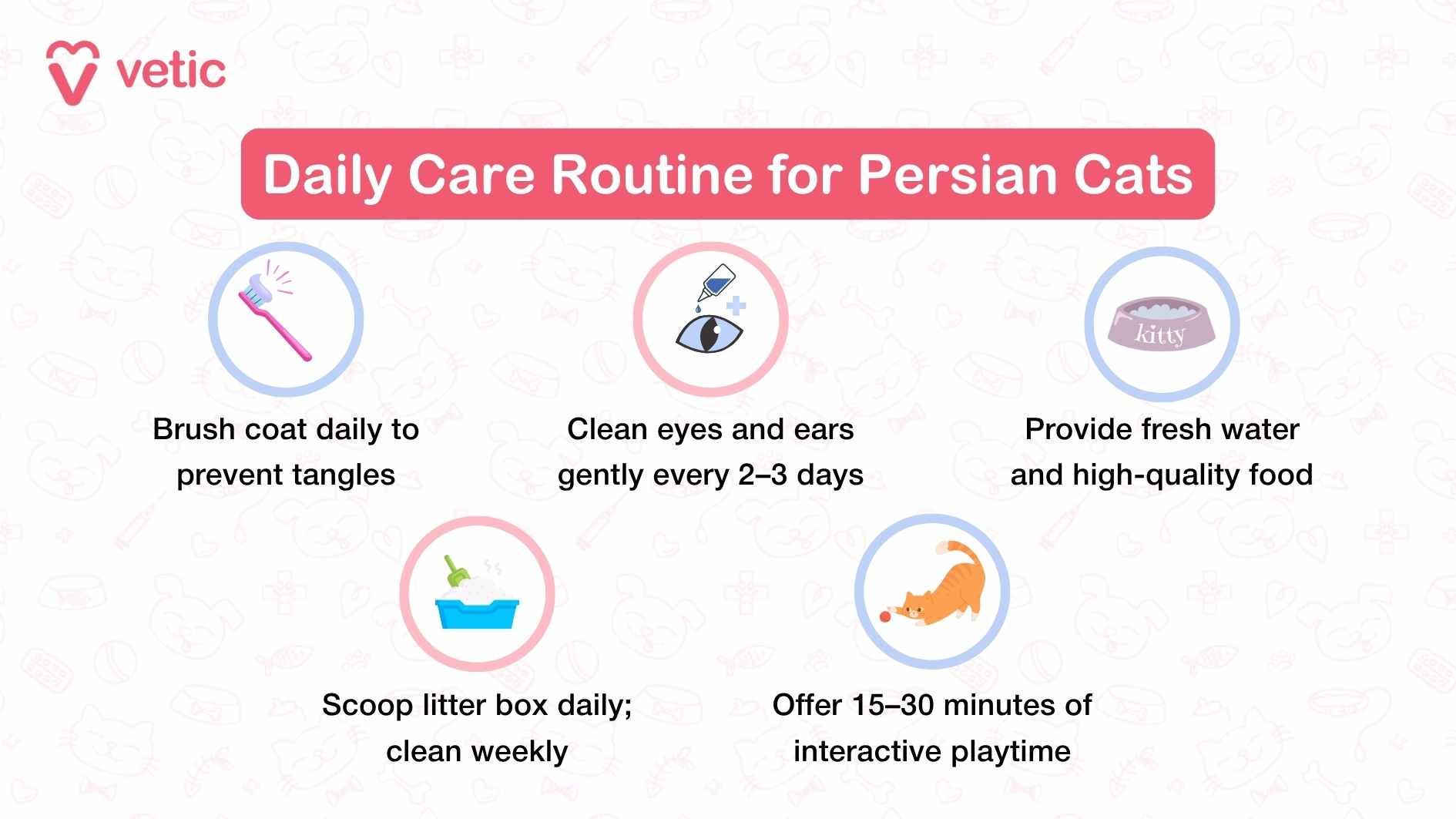
To reduce shedding in Persian cats:
- Brush daily with a slicker brush and deshedding comb
- Feed a balanced, omega-3 rich diet
- Keep your cat hydrated
- Bathe monthly with a mild cat shampoo
Seasonal shedding is normal, but excessive fur loss may indicate stress, poor diet, or skin disease. Our veterinary team suggests supplementing with vet-approved omega-3s and ensuring your Persian is parasite-free. Regular grooming and nutrition are the best defense against fur all over your furniture!
What shampoo is safe for Persian cats?
Use a mild, pH-balanced cat shampoo specifically designed for long-haired breeds. Avoid shampoos with parabens, sulfates, or artificial fragrances. Hypoallergenic or oatmeal-based formulas are ideal for Persians with sensitive skin. Never use human shampoos—they can disrupt a cat’s skin barrier. According to the American Society for the Prevention of Cruelty to Animals (ASPCA), always patch-test new products and rinse thoroughly. Medicated shampoos for skin issues should only be used under veterinary advice.
Section 2: Health, Illness & Preventive Care
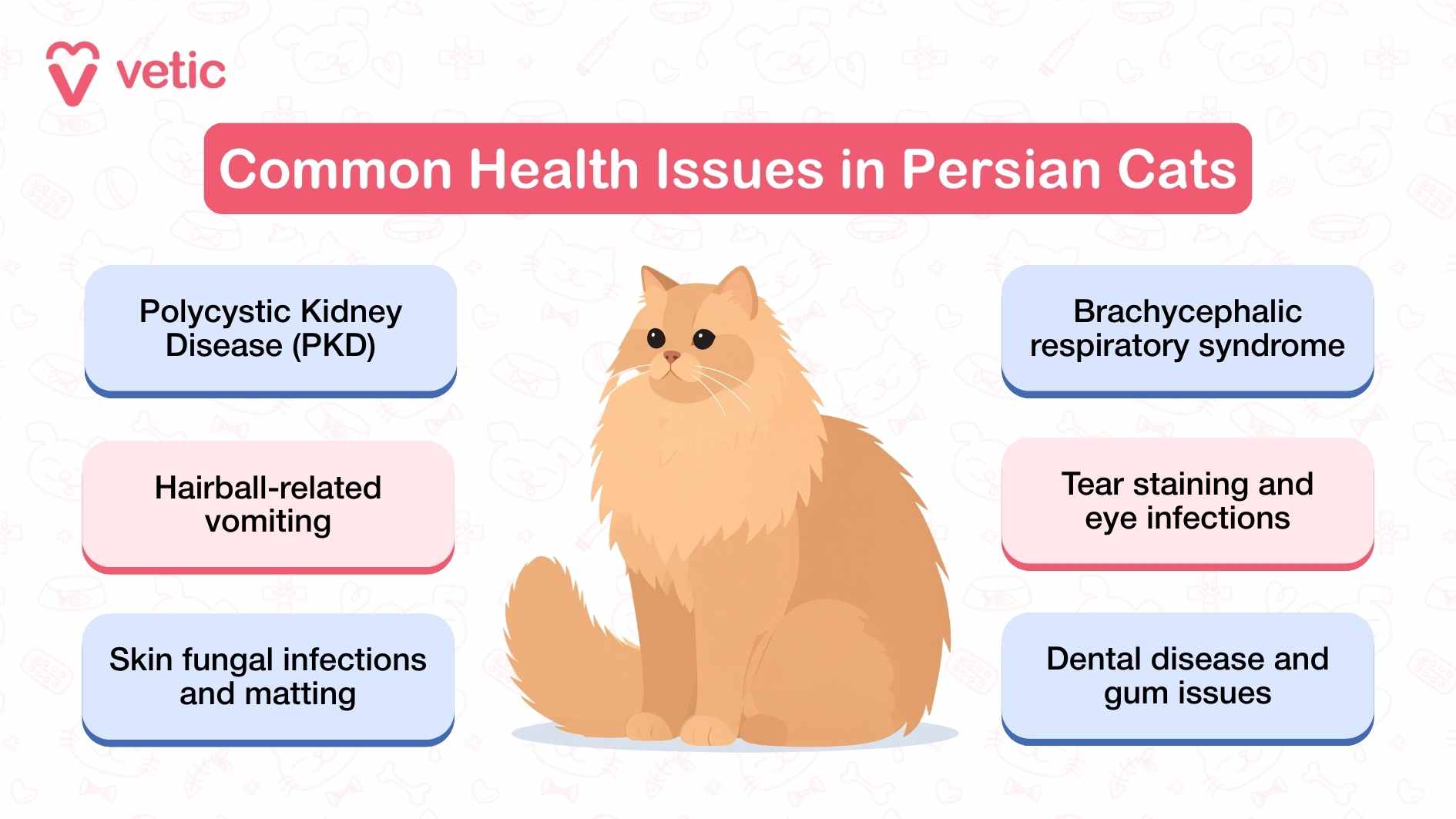
How do I tell if my Persian cat is dehydrated?
Signs of dehydration in Persian cats include dry gums, sunken eyes, lethargy, panting, and skin that doesn’t snap back quickly when gently pinched. A dry or sticky mouth is another clue. You can also check for reduced appetite or urination. According to Dr. Abhishek Choudhary, “Long-haired breeds like Persians may hide symptoms, so subtle changes matter. Recurring dehydration demands veterinary attention—underlying causes could be kidney disease or heat stress.”
Why is my Persian cat’s nose dry or cracked?
A dry or cracked nose in Persian cats may occur due to dehydration, sun exposure, heat, or even indoor air dryness. It’s not always a sign of illness—unless it’s accompanied by crusts, bleeding, sneezing, or discharge. Cats with flat faces like Persians are prone to nasal dryness due to shallow nasal passages. Apply a vet-recommended balm and ensure hydration. Avoid using human moisturizers—they can be toxic to cats.
Can Persian cats suffer from heatstroke?
Yes, Persian cats are highly prone to heatstroke due to their brachycephalic (flat-faced) anatomy, which makes cooling down harder. Signs include panting, drooling, vomiting, lethargy, and collapse. According to Dr. Abhishek Choudhary, “Heatstroke in cats can be fatal if not treated immediately. Always provide cool, shaded areas, plenty of fresh water, and avoid zero cuts during summer months.” Air conditioning is recommended in hot Indian summers, especially for Persians.
Are Persian cats more prone to respiratory issues?
Yes, Persian cats are genetically predisposed to brachycephalic airway syndrome, a condition linked to their flat facial structure. This can cause noisy breathing, snoring, and difficulty during physical activity or in hot weather. According to a 2023 International Cat Care study, Persian cats also face higher risks of nasal obstructions, chronic sinusitis, and tear drainage problems. Regular vet checks and a stress-free environment help manage their respiratory health.
What vaccines and deworming are mandatory for Persian cats in India?
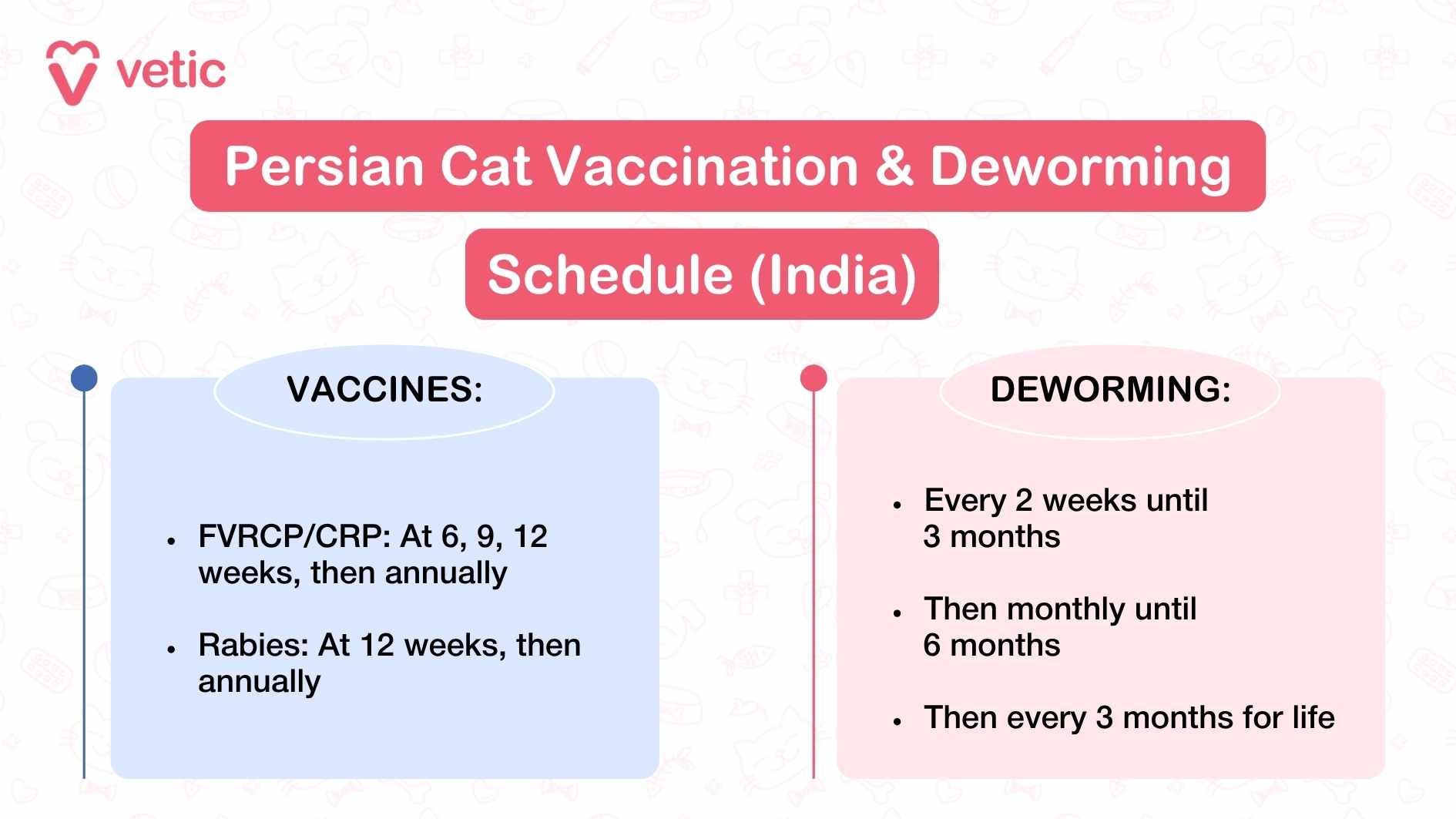
Core vaccines for Persian cats in India include:
- FVRCP or CRP (Feline viral rhinotracheitis, calicivirus, panleukopenia)
- Anti-rabies vaccine (legally required)
Deworming schedule: Every 2 weeks till 3 months of age, then monthly till 6 months, and quarterly thereafter. Use broad-spectrum dewormers like pyrantel-praziquantel combinations. According to the team of expert veterinarians at Vetic, indoor cats should also follow routine parasite control.
Kidney & Genetic Concerns of Persian Cat
Can Persian cats live a long life with PKD?
Yes, Persian cats can live a relatively long life with Polycystic Kidney Disease (PKD), especially with early diagnosis and proper management. While PKD is progressive, many cats with mild to moderate disease live 8–12 years or more. According to the International Renal Interest Society (IRIS), timely care—like a renal-supportive diet, hydration, and regular monitoring—can delay kidney failure. Cats diagnosed early and managed proactively often show stable kidney values for years.
Is there a cure for PKD in Persian cats?
There is no cure for PKD in Persian cats at present. Treatment focuses on managing chronic kidney disease (CKD) symptoms and slowing the progression of renal damage. However, experimental treatments—like CRISPR-based gene therapies—are under investigation for inherited diseases like autosomal dominant PKD, as noted in a 2024 paper published in the Journal of Translational International Medicine. For now, early detection, renal diets, and regular checkups remain the gold standard for care. (Xue et al., 2025, 543-552)
How often should I screen my Persian cat for kidney disease?

Begin annual kidney screenings (blood tests + ultrasound) from age 2 if your Persian cat is from a PKD-prone lineage. Get an ultrasound screening as early as 12 months if there’s a known genetic history. After diagnosis, cats should be monitored every 6–12 months depending on disease progression. Early detection is key—routine blood creatinine, SDMA, and urine protein tests can track declining kidney function.
What diet is best for a Persian cat with kidney disease?
A Persian cat with kidney disease should be fed a renal-support diet that’s low in phosphorus, moderate in high-quality protein, and rich in omega-3 fatty acids. Wet food is preferred to boost hydration. Brands like Royal Canin Renal, Farmina N&D Renal, and Vetlife Pro Renal are recommended by our veterinarians at Vetic. These diets help reduce kidney workload and slow disease progression. Avoid treats and high-sodium or high-phosphorus foods unless cleared by a vet.
Can PKD be detected before symptoms appear?
Yes, PKD can be detected before symptoms appear through ultrasound and genetic testing. Most affected Persian cats are born with cysts, but clinical signs may not show until later in life. The American College of Veterinary Internal Medicine (ACVIM) emphasises the screening of Persian cats by 10 months of age. Early detection allows for dietary changes and monitoring that can slow disease progression. This proactive approach is especially important in high-risk breeds like Persians.
Is genetic testing for PKD available in India?
Yes, genetic testing for PKD is available in India through select veterinary diagnostic labs and international partners. The test detects mutations in the PKD1 gene, responsible for most feline PKD cases. Labs offer feline genetic testing panels, often in collaboration with vets. Ideally, testing is done before breeding or by the time your Persian kitten turns 6–10 months. A simple buccal swab or blood sample is used for testing. (Evangelista & Steagall, 2021)
Behaviour, Socialisation & Mental Stimulation
Are Persian cats affectionate or aloof?
Persian cats are generally affectionate, gentle, and enjoy close companionship with their humans. They’re known to form strong bonds but express love subtly—they may prefer sitting beside you rather than on your lap. According to International Cat Care, Persians are more laid-back and emotionally tuned-in than many other breeds. While not clingy, they do crave routine and calm interactions. Aloofness can appear if they feel stressed, unwell, or overstimulated.
Why does my Persian cat meow so much?
Excessive meowing in Persian cats may be due to hunger, boredom, attention-seeking, stress, or underlying health issues like pain or hyperthyroidism. Persians are usually quiet, so a sudden increase in vocalisation warrants attention. Changes in behavior or vocal patterns should prompt a vet visit to rule out illness. Ensure your cat’s needs—social, emotional, and physical—are being met. Some also meow more at night due to loneliness or habit.
Do Persian cats need companionship or can they live alone?
Persian cats can adapt to alone time but thrive best with regular human interaction. They form strong bonds and may feel lonely or anxious if left alone for extended hours daily. Enrichment and companionship are essential for a cat’s emotional well-being. If you’re away often, consider a second pet (if well-matched) or enrich the environment with toys, scratchers, and perches to keep your Persian engaged.
How do I keep my Persian cat mentally stimulated?
Mental stimulation for Persian cats includes:
- Puzzle feeders
- Interactive toys (feathers, motion toys)
- Window perches and cat trees
- Short, gentle play sessions
- Scented toys or catnip
- Training tricks using treats
According to expert vets, mentally enriched cats show fewer behavioral problems and live happier lives. Rotate toys weekly to prevent boredom and engage in daily playtime—Persians may be low-energy, but they still need stimulation!
Why is my Persian kitten suddenly aggressive?
Sudden aggression in Persian kittens could stem from:
- Overstimulation (too much petting or rough handling)
- Fear or anxiety
- Pain or illness
- Lack of socialization
- Teething or frustration
Kittens can show fear-based aggression if startled or handled abruptly. It’s important to observe triggers and use calm, consistent training. If aggression persists, rule out medical issues through a vet check—dental discomfort or GI pain can often manifest as defensive behavior.
Why does my Persian cat bite when I pet it?
This behavior is often called petting-induced aggression, where cats become overstimulated during extended petting. Sensitive areas like the tail base or tummy can trigger a bite if touched too long. Persians, though calm, may have lower thresholds for physical contact. Watch for early signs like tail twitching, skin rippling, or flattened ears—these are cues to stop. Always pet your Persian gently and on preferred areas like the head and neck.
Life Stages & Special Needs
How do I care for an elderly Persian cat?
Senior Persian cats need special attention to their diet, mobility, grooming, and health screenings. Feed a senior-appropriate diet with kidney and joint support. Schedule vet checkups every 6 months and monitor for signs of arthritis, dental issues, or weight changes. Brush daily to prevent matting, and ensure easy access to litter trays and food bowls.
What changes should I expect as my Persian cat ages?
As Persian cats age, you may notice decreased activity, longer naps, duller coat, weight gain or loss, and potential dental or kidney issues. Some may develop arthritis or vision and hearing decline. Behavioral changes like increased vocalization or confusion could also signal cognitive dysfunction. Regular wellness checks and early detection can greatly improve quality of life in older cats.
How long do Persian cats typically live?
Persian cats typically live 12 to 17 years, with some reaching up to 20 with excellent care. Their lifespan depends on genetics, diet, indoor lifestyle, and proactive healthcare. Dr Abhishek Choudhary states, “Persian cats are prone to conditions like PKD, dental disease, and respiratory issues, which may impact longevity.” Early screening and preventive care can significantly extend their lifespan.
What are signs of pain or discomfort in Persian cats?
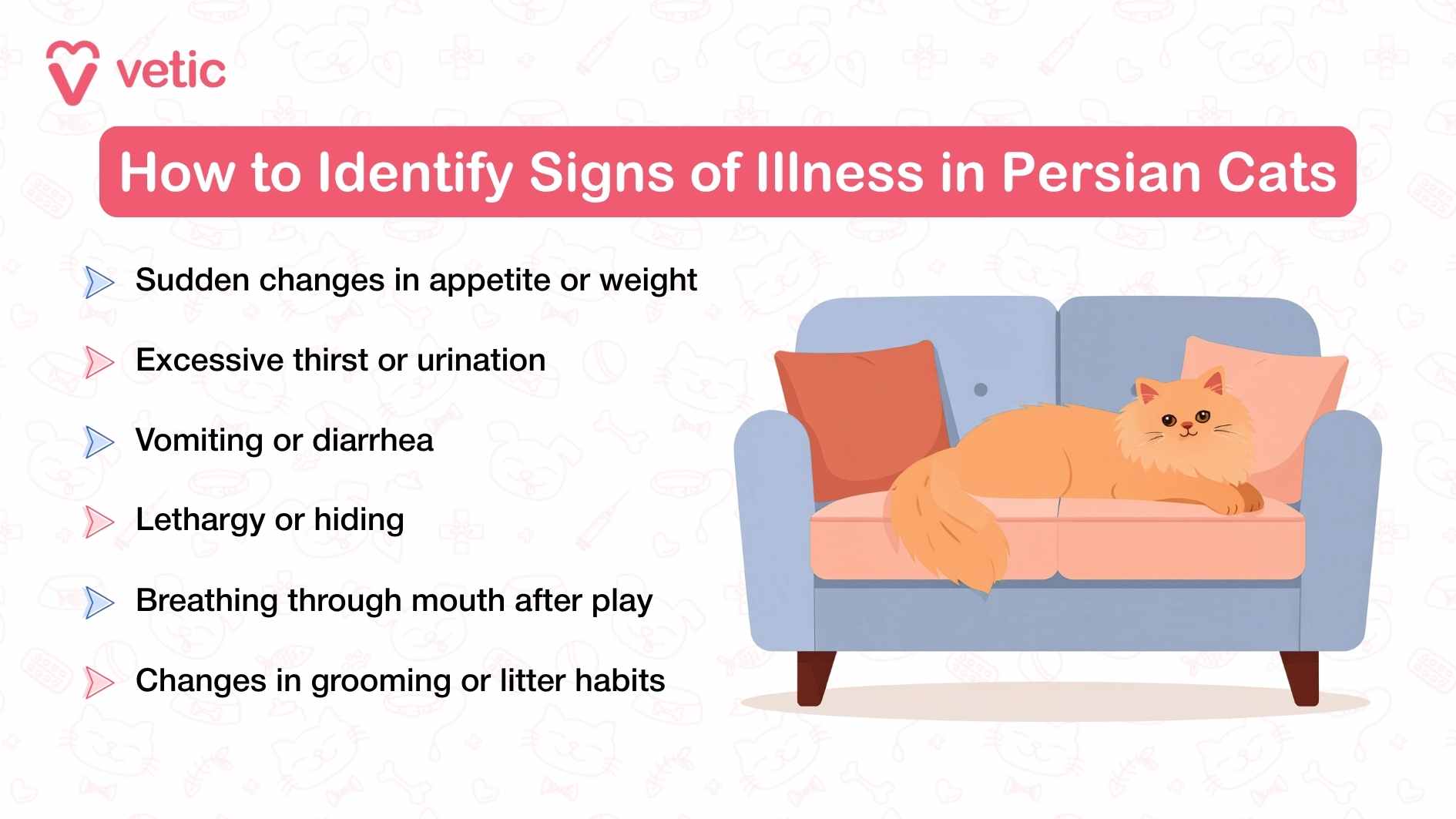
Cats hide pain well. Watch for reduced grooming, appetite loss, hiding, hunching, aggression when touched, or reluctance to jump. In Persians, excessive matting, changes in litter habits, or facial expression changes can be subtle signs. The Feline Grimace Scale, is a helpful tool to assess pain through eye, ear, and whisker position. Always consult your vet if you suspect discomfort. (Evangelista & Steagall, 2021)
When should I switch from kitten to adult food for Persians?
Persian kittens should transition to adult food at 12 months of age, once they reach full growth. Continue feeding a high-protein kitten formula until then to support development. According to WSAVA Global Nutrition Guidelines, the switch should be gradual over 7–10 days to avoid digestive upset. Choose a breed-specific adult diet that supports skin, coat, and kidney health—key areas for Persian cats.
Persian cats may look royal, but they require a king’s share of care. From daily grooming to regular health check-ups, they demand attention and preventive care to stay healthy and comfortable. Their delicate health, flat-faced anatomy, and breed-specific risks mean they’re not always low-maintenance. First-time pet parents must be prepared for the commitment—emotionally and financially. With the right care, though, a Persian cat can be a gentle, affectionate companion for many years to come.
References
Evangelista, M. C., & Steagall, P. V. (2021, March). Agreement and reliability of the Feline Grimace Scale among cat owners, veterinarians, veterinary students and nurses. Nature Sci Rep, 11(5262). https://doi.org/10.1038/s41598-021-84696-7
Moazezi, Jamshidi, Ashrafi, & Zangisheh. (2022). Molecular detection of polycystic kidney disease in Persian and Persian-related breeds in Iran. Journal of Feline Medicine and Surgery Open Reports, 8(1). 10.1177/20551169211070991
Xue, C., Lv, J., Yang, B., Xu, J., Li, X., Zhang, L., Mao, Z., & Mei, S. (2025). Gene therapy in polycystic kidney disease: A promising future. J Transl Int Med, 12(6), 543-552. 10.1515/jtim-2024-0021
